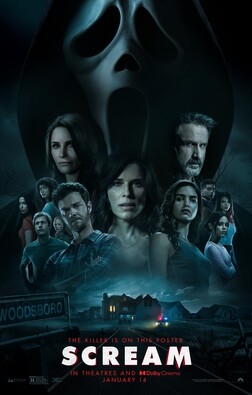While new and fresh ideas are popping up all the time in the world of horror films, particularly amongst indie circles, some of the older nightmares can be just as potent. This is why films and franchises from as far back as the 1920s are to this day being graced with sequels, reboots and complete remakes. Of course it can be argued that to remake an old horror property is simply an attempt at draining the pockets of the nostalgia-susceptible, but a lot of creators go into such a process with a deep love of that original, be it Nightmare on Elm Street, The Evil Dead, or The Invisible Man. Sometimes people simply want to capture the essence of what made one of their favourite films great and share that with a modern audience, though a few recent entries have had trickier, cleverer ideas up their sleeves. As we are about to see, the line between ‘terrifyingly worthy tribute’ and ‘embarrassment to its predecessor’ can be a fine one, and not all make the cut.
Texas Chainsaw Massacre (2022)
Tobe Hooper’s 1974 horror classic The Texas Chainsaw Massacre was scary bordering on masochistic, and since then has been tarnished with a horde of shoddy sequels and rebooted more times than an 80s Macintosh. Filmmakers seem content simply chopping different bits off the original’s title each time they reset; first we had The Texas Chainsaw Massacre (2003), and then Texas Chainsaw (2013), and now Texas Chainsaw Massacre (2022) horror remake. Many try to tack on enough lore just to fill and warrant their runtime, though our skin-masked maniac’s latest outing seems far more heavily focused on gore. Of course, gore isn’t what made Hooper’s masterpiece what it is, but it certainly helped. Sadly David Blue Garcia’s take utilises mainly CGI gore that can tend to look animated when it ramps up, and Leatherface himself never felt immediate enough to be actually scary. Olwen Fouere plays a returning Sally Hardesty (played originally by Marilyn Burns) in what seems like an attempt at the ‘returning leads in horror’ trend currently headed by Jamie Lee Curtis and most of the Scream (1996) cast, though Sally’s comeback was in no way as effective or as thought-out as the aforementioned. While it is worth a watch for gore completionists, Texas Chainsaw Massacre ultimately proves itself to be merely another in a lengthening line.
Scream (2022)

Tyler Gillett and Matt Bettinelli-Olpin got a lot of things right with Scream (2022); it was rife with the meta-awareness of its predecessors and aware of the change in their relatability as the years had gone on, perfectly willing to integrate itself into the new modern age and do so effectively. It brought back cast favourites from the very beginning of the franchise and even got so meta as to question what kind of addition to the franchise it really was, coining the term ‘requel’: not quite a horror remake, not quite a sequel.
Scream (2022) is a clever whodunit horror, though somewhere along the way it forgot to be scary. Aside from a couple of tension-building moments, most of the runtime is spent winking to the audience rather than actually being a horror film. Still, it is a funny, self-aware and welcome addition to the franchise, one that fans of any of the previous sequels will likely enjoy.
Friday 13th (2009)
Friday 13th (2009) is an example of a reboot that simply didn’t do enough to distinguish itself from its predecessors. While technically-sound and boasting plenty of gore, director Marcus Nispel’s (director of 2003’s The Texas Chainsaw Massacre reboot) vision sadly followed too many of the same beats as practically every other film in the long-running franchise, proving that a sleek, modern look isn’t all that’s required to resurrect someone like the immortal Jason Voorhees.
The story does take some interesting turns, though all we are eventually left with are a handful of 00’s horror cliches and hollow half-scares. With a ‘reimagining’ like this, some expectations arguably have to be subverted, otherwise what is the production but an attempt to milk some more cash from the franchise? Unfortunately everything here that is expected to happen, happens, and the experience as a whole is forgettable, even in terms of late-stage Friday 13th titles.
Resident Evil: Welcome to Raccoon City (2022)

Welcome To Raccoon City is an indisputable homage to the golden era of the Resident Evil game series, though it also throws into question whether or not this is a good thing for a film. Paul W.S. Anderson’s take on the series was heavily flawed and received mostly negative feedback, especially as it went on, and one of the factors for this was always thought to be its departure from the plot and themes of the games in favour of the story of Alice, played by Anderson’s wife Milla Jovovich. Now that we have a perfectly functioning cinematic version of the games themselves, complete with likeable cast, plenty of action and great callbacks to the originals, it becomes apparent that the problem may not have been wholly with Alice. Following the beats that the Resident Evil games did actually makes for quite a hollow cinematic experience, even when done with all the heart and care a fan can muster.
Wrong Turn (2021)
Here was a hell of a curveball in terms of horror reboots. While not by any means perfect, Wrong Turn (2021) completely reinvented the meaning of backwoods brutality by swapping out its predecessors’ cackling mutant hillbillies for The Foundation, a group who rejected modern society to live in the woodland, and who protect their way of life using savage measures.
Wrong Turn does lay it on thick in terms of political ideology, and it is odd to see a film in the series take itself so seriously. That being said, the film’s balance between being that of strong ideas and that of a strong body-count is what keeps it afloat for the majority of its runtime. Some truly haunting imagery and wince-inducing kills make up for the shaky pacing and ridiculous choices of its lead characters (it is a slasher after all). Anyone interested in seeing the effects of some gruesome woodland booby traps will find more than enough here to enjoy.
Evil Dead (2013)

My personal favourite horror reboot. Evil Dead (2013) manages to capture perfectly the ferocious insanity of the original while also creating a uniquely dark spin on its story. Five friends spend a night in a cabin in the woods to cure one of their heroin addictions. When addict Mia (Jane Levy) begins facing demonic and invasive threats, she must convince her friends that far more than withdrawal is plaguing her before it is too late. Fede Alvarez manages to keep some key items as love letters to Raimi’s legendary films, such as that tree for example, and amps up the gore and violence to vomit-worthy levels. Faces are stabbed, hands are split, heads are chainsawed and all is done with a gleeful knowingness of what makes Evil Dead special. Let’s not forget the iconic Necronomicon, which makes an appearance as well. And with Evil Dead: Rise just around the corner, it’s nice to know there’s a future for such an uncompromising horror entity.
Halloween (2018)
Blumhouse’s Halloween reboot is one of their better horror films. What makes Michael Myers scary is the apparent randomness to his killings, and Halloween (2018) knew exactly where to go with it. After a shaky intro (what is even happening there? Does Michael have the ability to send the mentally ill into a frenzy?) we are then given a very solid setup involving a returning Jamie Lee Curtis as Laurie Strode, her family, Michael’s foreboding transfer from psychiatric hospital to maximum security prison (what could go wrong?) and even a little self-awareness with the ‘by today’s standards’ quip. Instead of Laurie returning in the same brief way Sally Hardesty did, she and her family are key players in Michael’s latest bloodbath, showing Laurie’s preparation and the deadly results it yielded.
Joe first knew he wanted to write in year six after plaguing his teacher’s dreams with a harrowing story of World War prisoners and an insidious ‘book of the dead’. Clearly infatuated with horror, and wearing his influences on his sleeve, he dabbled in some smaller pieces before starting work on his condensed sci-fi epic, System Reset in 2013.Once this was published he began work on many smaller horror stories and poems in bid to harness and connect with his own fears and passions and build on his craft.
Joe is obsessed with atmosphere and aesthetic, big concepts and even bigger senses of scale, feeding on cosmic horror of the deep sea and vastness of space and the emotions these can invoke. His main fixes within the dark arts include horror films, extreme metal music and the bleakest of poetry and science fiction literature.
He holds a deep respect for plot, creative flow and the context of art, and hopes to forge deeper connections between them around filmmakers dabbling in the dark and macabre.
